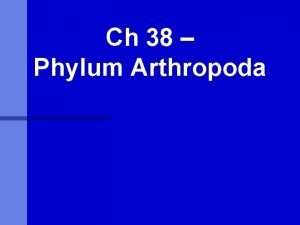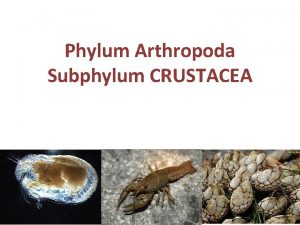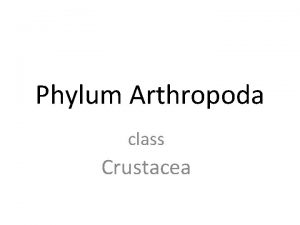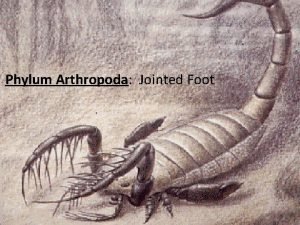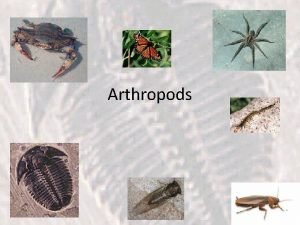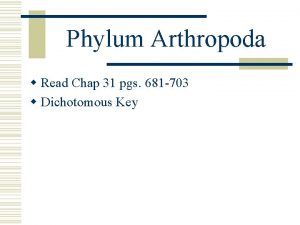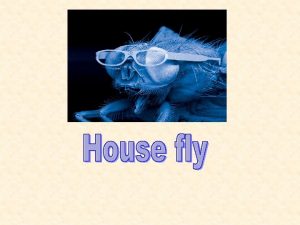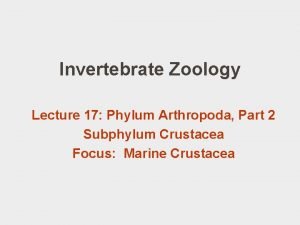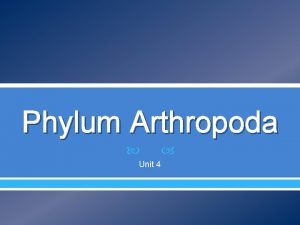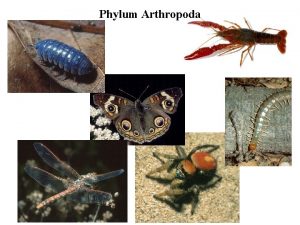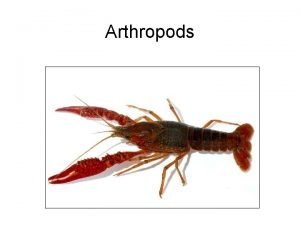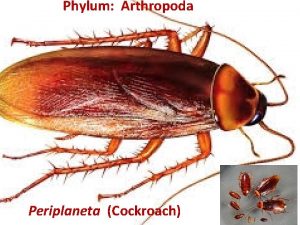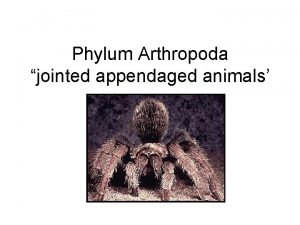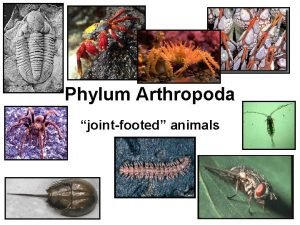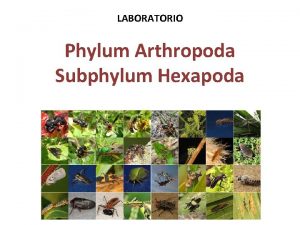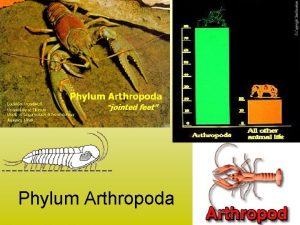Phylum Arthropoda l o Phylum Arthropoda l o
















- Slides: 16

Phylum: Arthropoda l o

Phylum: Arthropoda l o

Arthropoda Origin of the word Arthropoda: Jointed Foot Common Examples: Insects, Spiders, Crabs Symmetry: Bilateral Type of body cavity: Coelomate

General Arthropod Body Plan •

Characteristics of Arthropods 1) Jointed appendages: Arms and legs with freely moving joints. Early arthropods: have appendages on each segment Modern arthropods: have appendages on a few segments.

Specialization of Appendages Functions of Appendages: 1) Running 2) Catching prey 3) Feeding (Sharp mandibles) 4) Swimming 5) Reproducing 6) Sensory reception

Exoskeleton 2) Exoskeleton: Strong chitin shell found on the outside of the organisms body Used for: - Protection - Skeleton to support muscle - Prevent desiccation (drying out)

Exoskeleton Molt: The exoskeleton is not capable of expanding. When the organism inside the exoskeleton grows too large it must form a new exoskeleton inside the old one. When the new one is ready it will shed the old one. Once free the new exoskeleton expands and hardens

Segmentation 3) Segmentation in arthropods: Segments are fuse into regions.

Nervous System Arthropod Nervous System: Three parts 1) Brain 2) Ventral solid nerve cord 3) Sense organs: - Antennae - Simple eyes - One pair of compound eyes Compound eyes produce a clearer image then the mammalian eye

Subphylum: Crustaceans: Have high levels of calcium in their shells - Mainly marine arthropods. Barnacles, crabs, lobsters and shrimp - Freshwater examples include crayfish, freshwater crabs and shrimp. - Land examples include pillbugs

Subphylum Uniramia Subphylum Unirami: Insects Entomology: The study of insects Characteristics of insects: 1) Three parts of the body: head, thorax, abdomen, 2) One pair of eyes and several smaller eyes

Subphylum Uniramia Subphylum Unirami: Insects Entomology: The study of insects Characteristics of insects: 1) Three parts of the body: head, thorax, abdomen, 2) One pair of eyes and several smaller eyes 3) One pair of antennae 4) Specialized mouthparts

Subphylum Uniramia Subphylum Unirami: Insects Entomology: The study of insects Characteristics of insects: 1) Three parts of the body: head, thorax, abdomen, 2) One pair of eyes and several smaller eyes 3) One pair of antennae 4) Specialized mouthparts 5) One or two pairs of wings - Escape enemies - Finding food - Mating - Dispersing offspring

Subphylum: Chelicerates (Arachnids Scorpions, Spiders, ticks, mites) 1) 6 pairs of appendages - 2 chelicerae - 2 pedipalps - 4 pairs of walking legs 2) Two body parts: - Cephalothorax: Head and legs - Abdomen: Contains the organs

Assignment • Vocab: 640 - 646
 Arthropoda
Arthropoda Subphylum uniramia
Subphylum uniramia Phylum arthropoda subphylum crustacea
Phylum arthropoda subphylum crustacea Phylum artropoda
Phylum artropoda Kingdom animalia phylum arthropoda
Kingdom animalia phylum arthropoda Arthropods characteristics
Arthropods characteristics Crayfish phylum and class
Crayfish phylum and class Arthropoden definition
Arthropoden definition Common name of arthropoda
Common name of arthropoda Introduction of phylum arthropoda
Introduction of phylum arthropoda Dichotomous key
Dichotomous key Diptera phylum
Diptera phylum Pereopods
Pereopods Phylum arthropoda
Phylum arthropoda Nervous system of arthropods
Nervous system of arthropods Brittle stars phylum
Brittle stars phylum Jointed appendages definition biology
Jointed appendages definition biology

